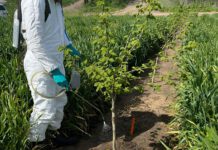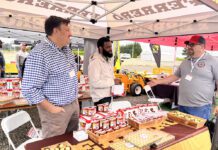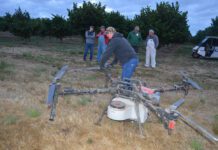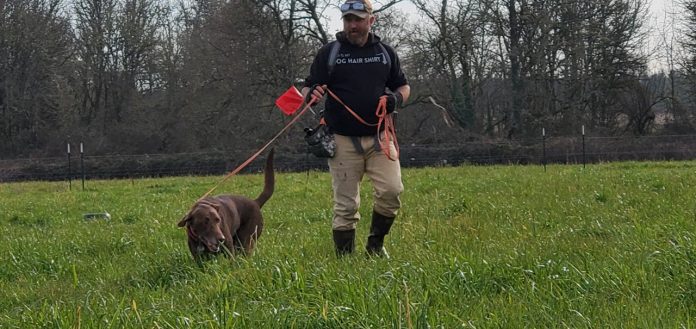
An Oregon State University research project aimed at improving the identification of active vole holes is showing promise and one day could help hazelnut growers find and treat for the pests.
The project, initiated last year, involves using dogs to identify which of the many vole holes in a field or orchard are being used. Better understanding of where voles are in a field or orchard can help growers more accurately and quickly trap or treat for the pests.
“The idea is to take the million vole holes down to a few vole holes that actually have a vole associated with them right at that moment,” said Dana Sanchez, a wildlife extension biologist at OSU who is involved in the project.
The project involves trapping for voles in January and February before their breeding season.
“Doing this proactively before the breeding season starts is going to be more effective than waiting until the height of the growing season when voles have gone through umpteen generations,” Sanchez said.
“We are talking about doing this in the dead of winter, so January and February,” she said. “It doesn’t mean that no voles are breeding, but most are not. I see that as a time for getting more bang for your buck. For every vole you kill, you are reducing the productivity capacity in that area.”
‘They Can Be Devastating’
Voles, specifically gray tailed voles, “can be devastating” to hazelnut trees, according to Nik Wiman, orchard crops specialist for OSU Extension.
“They can very quickly girdle trees at the base by chewing off the bark and cambium as they work their way around,” Wiman said. “Depending on how far around the trunk they get, the tree dies a slow death and it makes it difficult for growers to decide which trees are worth keeping and which need to be culled.”
If the girdle doesn’t extend more than 25% of the circumference of a tree, the tree will be weaker but will live and produce nuts, Wiman said.
“For shallow-rooted trees, they may chew off the bark on exposed roots rather than go for the main stem,” Wiman added. “I would say the tree can tolerate more of that than the trunk girdling.”
Intercropping a seed crop in young orchards, an increasingly common practice, can lead to particularly bad damage, Wiman said, as after the crop is harvested and their homes terminated, voles start attacking trees.
In cover crop situations, voles typically will stay in the alleys, Wiman said, as long as the cover crop is maintained. But once it is terminated, they will attack trees.
Wiman said he has seen particularly high damage to trees after a neighboring grass seed field is harvested and tilled. “The voles suddenly find themselves without food or cover and then migrate into the orchard and start attacking trees,” Wiman said.
Usually, trees on the edges of orchard are most damaged in these cases, Wiman said. “But voles can also use tile lines for getting around, so damage can be anywhere.
“I think in some cases they are after the moisture in the sap, but the cambium wood is very nutritious too,” Wiman said. “I’ve documented an example where they selectively attacked only a specific pollinizer variety in an orchard, so they may have preferences for certain trees.”
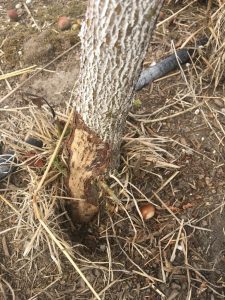
Promising Results
In preliminary results of the two-year research project, the researchers found that canine assisted detection far outperformed human detection in determining which vole holes were active.
“When we totaled search time invested across farms and teams for our abbreviated season, it was evident that canine detection teams (97 minutes) were far faster in field scouting and identifying which holes to trap compared to an unassisted human (232 minutes),” the researchers wrote in a report on the study.
Researchers conducted the research in two vegetable farms, two pastures and one hazelnut orchard in their first year.
Researchers were forced to cut short their season because of complications with housing and handling voles due to an outbreak of leptospirosis, a disease that infects mammalian species worldwide and one that can spread rapidly through vole populations. Still, they characterized the preliminary results as promising.
The researchers are focusing on pasture crops in 2023 because of complications they encountered in vegetable crops and hazelnuts in 2022 and because pasture crops tend to have a more consistent population of voles, according to Nick Andrews, an associate professor of practice in OSU’s College of Agricultural Sciences, who also is involved in the research.
“We are hoping if the results are still promising [in 2023] that the general approach of locating the voles will be applicable in a lot of other cropping systems,” Andrews said.
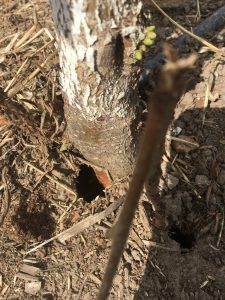
Laborious, Time Consuming
Scouting fields and orchards for voles can be laborious and time consuming, Andrews said. Burrow entrances can persist for years, and only through identifying signs of recent activities such as fresh scat can active tunnels be identified.
“There can be thousands of vole holes per acre with large tunnel networks,” the researchers wrote in their preliminary report, “but the holes and runs themselves cannot really indicate number of animals alive at a given time.”
Dogs, according to the report, “inherit from their wild forbearers tremendous abilities to scent, process and track odors.” These abilities are being used for security, medical and sporting purposes, but agriculturists are only beginning to explore different applications, the report stated.
In 2022, the researchers used two teams consisting of a dog and a trainer to identify active vole holes and compared their success rate to human scouting. They are planning to use three teams in 2023. They started training the dog teams in late 2021 in preparation for the 2022 season.
The success rate in 2022 “was definitely a green light to go ahead,” Sanchez said.
The researchers are focusing on six farms this year and will rotate the canine detection teams among the farms.
After the trapping portion of the project, the researchers plan to do damage assessment.
Hot Spots
Sanchez envisions growers someday utilizing canine-assisted detection in hot spots of fields or orchards rather than scouting an entire field.
“What we are hearing is there are many farmers who recognize that there are reservoir areas from which animals seem to be dispersing, like the higher-quality areas from the vole’s point of view,” Sanchez said. “So, if we can hit them when the population is low and make people more effective at targeting their treatment, then that would help.”
Sanchez noted that as part of the project, an OSU veterinarian is analyzing the strain of leptospirosis that is infecting the voles, a project that could help in developing of vaccines and other preventative measures for dairy cows, pet dogs and other mammals that suffer from the disease.
“It is nice to know that the animals that we are taking in this project are contributing in a significant way to another project,” Sanchez said.
The project is being funded by a USDA Western Sustainable Agriculture Research and Education program grant.







